
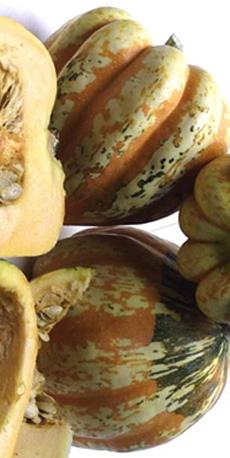 The festive-looking carnival squash is 5-7 inches in diameter, with a flavor similar to butternut squash. Photo courtesy of Melissas.com. The festive-looking carnival squash is 5-7 inches in diameter, with a flavor similar to butternut squash. Photo courtesy of Melissas.com.
|
MELISSA HOM is an editorial intern at THE NIBBLE.
|
|
June 2006
Updated October 2009
|
 |
Product Reviews / Main Nibbles / Vegetables
Squash Glossary
Types Of Squash For Summer, Winter And Year-Round
Page 5: Calabash Squash & Other Squash Types Beginning With C
This is Page 5 of an eight-page glossary featuring different types of squash. Here, squash types beginning with C include unusual squash types like the calabash, calabaza, carnival, Chinese okra, cinderella squash and cucuzza, and the more commonly-found chayote squash. And—surprise—the cucumber is a squash! Click on the black links below to visit the other pages; click here to recommend a variety of squash we haven’t included. See our more than 50 other food glossaries, each featuring a different favorite food.
| Type Of Squash |
Get To Know Me |
Calabash
The smooth, pale green calabash bottle gourd is multipurpose squash. Its white flesh is normally used in Chinese stir-fries or dried as strips in Japan. In Central America, its seeds are roasted and ground, then incorporated into a rice, cinnamon, and almond-based drink. The calabash’s dried shell can be used as bowls, containers, smoking pipes, bird houses or ornaments. As a musical instrument, it is made into maracas and the seeds inside rattled for percussion. Its hollow chamber allow for use as a string instrument, and it can also be turned into a drum. But perhaps the most unusual use is among the natives of New Guinea, where men wear it as a koteka, or a penis gourd or sheath, to cover the genitalia. The calabash can also be teardrop-shaped and many cultures add weights to the squash to help elongate it and create the typical bottle shape.
Available late summer and throughout fall. |
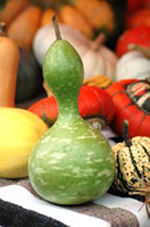
Looking like a food of the Jetsons on the one hand, the calabash squash is part of quite a few primitive cultures. You’ll be able to identify the other varieties in this Squash Glossary. Photo by Nathalie Dulex | SXC. |
| Calabaza or West Indian Squash
Round or pear-shaped, the calabaza squash ranges from beige to pale sunset colors. As its name implies, it is popular in the Caribbean, as well as Central and South America. It is similar to the butternut squash, but with a firmer and more fibrous texture.
Available year-round. |
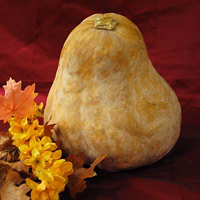 |
Carnival Squash
The beautiful carnival squash has a festive pattern with brush-like stripes of deep orange and specks of green. The meat inside is a golden yellow color similar to butternut squash and golden sweet potatoes, and is even creamier and sweeter.
Available year-round, but is best late summer through early fall. |
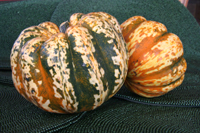
|
Chayote Squash or Christophen Squash
Also called a vegetable pear because of its shape, the chayote was originally cultivated in Central America. The apple- green squash is mild-tasting: refreshing like a cucumber, tender like zucchini, but crisp like an apple. Like zucchini, it can be eaten or prepared almost in any way. Try munching on it raw, over salad, or deep-fried. Though similar to summer squash, chayote has a firmer texture and usually requires a longer cooking time.
Available year-round, but the peak season is September through May.
|
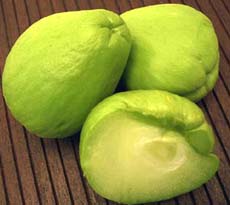
Photo courtesy of Melissas.com. |
Cheese Wheels or Cheese Pumpkin
Also known as the Long Island Cheese Pumpkin, this squash is squat and round like a wheel of cheese. The peach or orange exterior makes it a pumpkin look-a-like. They have very sweet flesh and are excellent in pies.
Available fall through winter.
|
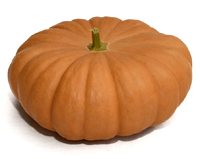 |
Chinese Okra, Luffa Gourd or Silk Melon
The Chinese okra tastes and cooks similarly to zucchini; the ridges add a decorative element to dishes and crudités. Neither needs to be peeled or seeded. Look for the young ones—older Chinese okra tends to be bitter, and the rough ridges and spine become tougher with age.
Available year-round, but the peak season is the summer and fall.
|
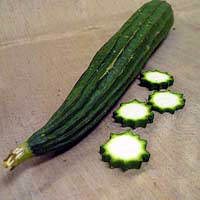 |
Cinderella Pumpkin or Red Etampes
This medium-sized round squash with a red-orange exterior and thin green streaks is also known as the red etampes. It resembles the pumpkin that Cinderella’s Fairy Godmother transformed into a carriage. Although perfectly edible, most use the Cinderella pumpkin as a decorative pumpkin.
Available late August throughout the fall. |
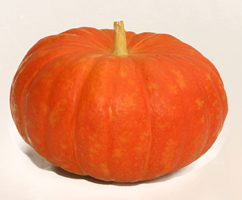 |
Crookneck Squash
A yellow squash with a thin curved neck; there are smooth-skin and and warty- skin varieties. Although they are summer squash, the taste is said to be more akin to winter squash. |
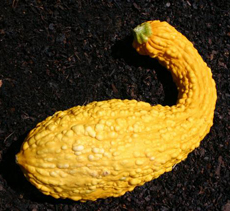
Photo courtesy of Morguefile. |
Cucumber
Cylindrical and green, cucumbers are popular choices for added crispness to salads, snacks, sushi rolls or sandwiches. When cooked they are tender; their taste is mild unless pickled. They are equally refreshing in soups, as a puréed sauce, and in ethnic dishes like the Greek cucumber and yogurt salad, tzatziki and in Indian raita (see recipes for both of these dishes). There are different varieties of cucumbers, but the main difference lies in the skin and seeds. An old wives’ tale has it that either the seeds or bitter skin causes people to burp, which is why “burpless” varieties were developed with thin skins and virtually no seeds.
Available year-round. |
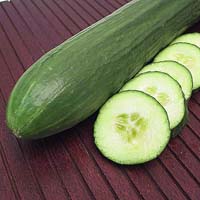
Who knew—the everyday cucumber is also a squash! |
Cucuzza or Italian Squash
“Cucuzza” is the general term for squash in Italian, so it makes sense that the cucuzza is also called Italian squash. Its long, curved and bottom-heavy body also earned it the title of “bottle gourd.” It can be prepared just like zucchini and has the same tender, mildly-sweet characteristics.
Available summer through fall. |
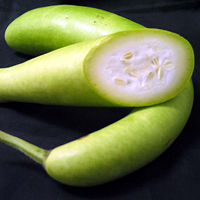 |
Cushaw Squash
See green-striped cushaw. |
|
Continue To Page 6: Squash Types Beginning With D To J
Go To Article Index Above
Lifestyle Direct, Inc. All rights reserved. The photos in this squash glossary are courtesy of Goebel Farms, Melissa’s, MorgueFile and Melissa Hom. Images are the copyright of their respective owners.

|
| |














